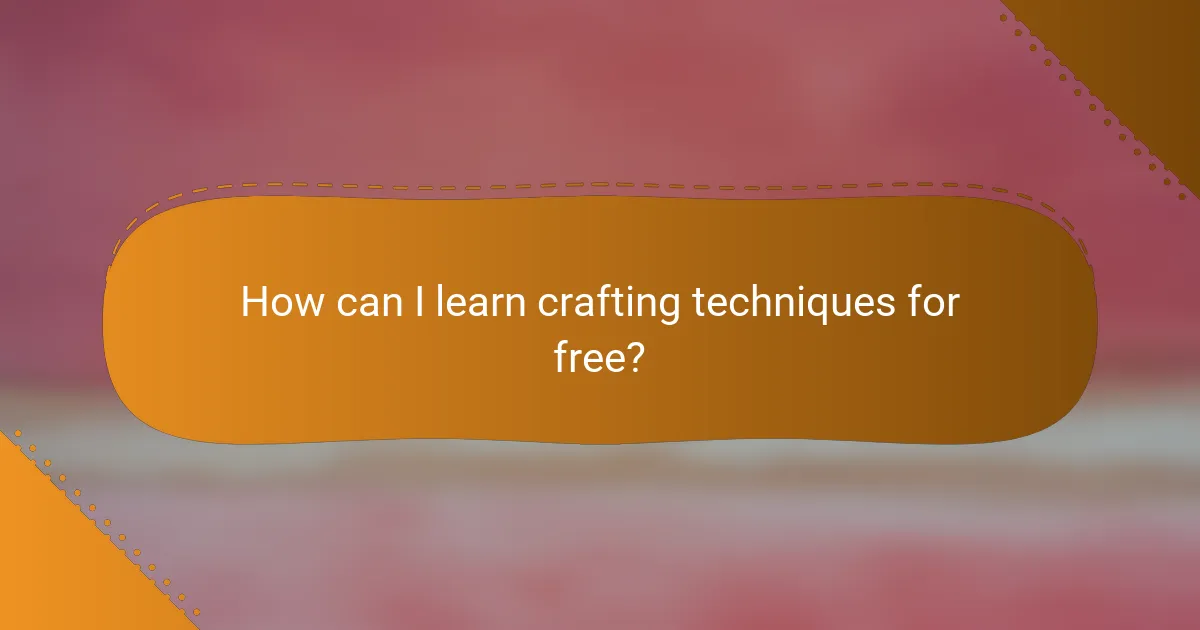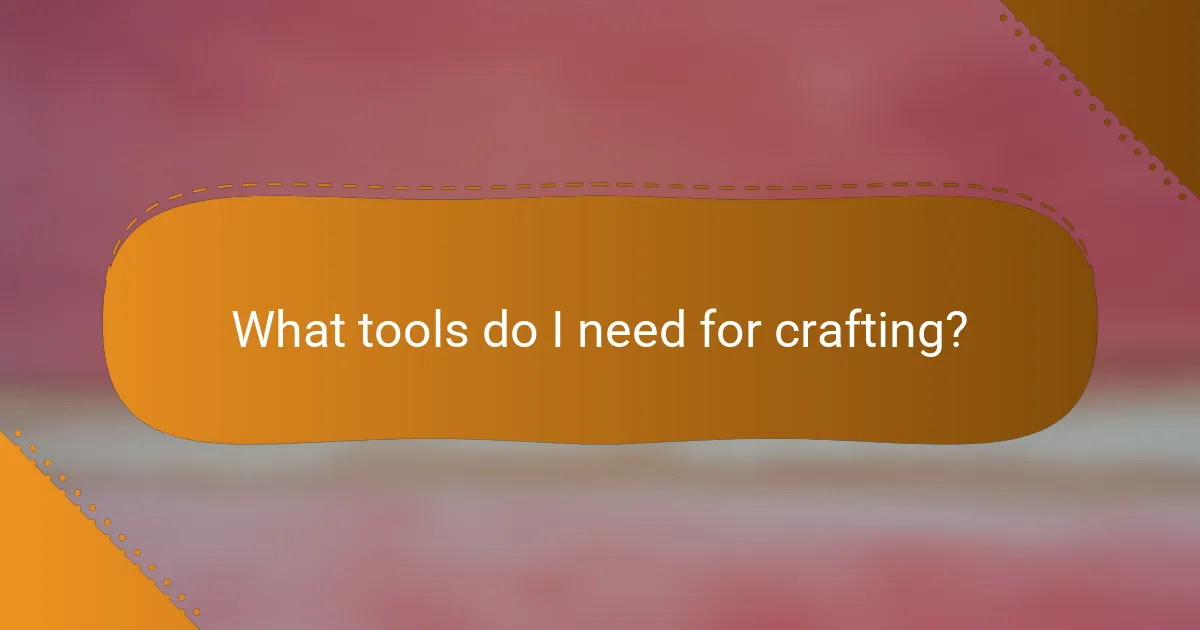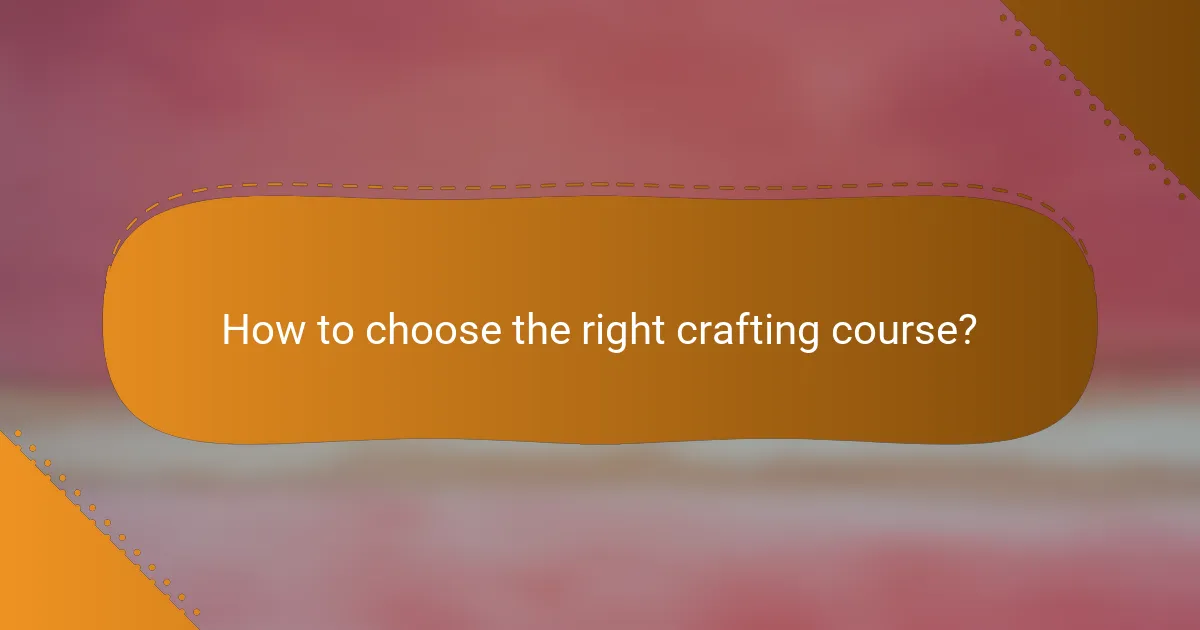Exploring crafting techniques can be an enriching experience, and numerous resources are available to help you get started. From online courses on platforms like Skillshare and Udemy to free tutorials and community forums, you can find a wealth of information tailored to your skill level and interests. With the right tools and guidance, you can enhance your crafting skills and unleash your creativity from the comfort of your home.

What are the best crafting courses available online?
The best online crafting courses cater to various skill levels and interests, offering flexibility and diverse techniques. Platforms like Skillshare, Udemy, and CreativeLive provide extensive libraries of classes that can enhance your crafting skills from the comfort of your home.
Skillshare Crafting Courses
Skillshare offers a wide range of crafting courses, focusing on practical skills and creative projects. You can find classes on topics such as knitting, sewing, and paper crafts, often taught by experienced artisans. Many courses are project-based, allowing you to create something tangible while learning.
Consider subscribing to Skillshare for unlimited access to thousands of classes. The platform typically operates on a monthly or annual subscription model, making it cost-effective for avid learners. Look for courses with high ratings and positive reviews to ensure quality instruction.
Udemy Crafting Techniques
Udemy features a diverse selection of crafting techniques, from beginner to advanced levels. Each course is individually priced, allowing you to choose specific topics that interest you, such as woodworking, jewelry making, or digital crafting. Udemy often offers discounts, making it affordable to explore multiple courses.
When selecting a course on Udemy, check the course length and student feedback. Many courses include lifetime access, so you can learn at your own pace and revisit materials as needed. Look for courses that provide downloadable resources for a more comprehensive learning experience.
CreativeLive Workshops
CreativeLive specializes in live workshops and on-demand classes, focusing on hands-on crafting techniques. The platform features expert instructors who guide you through various projects, making it ideal for those who prefer interactive learning. Topics range from photography to DIY home decor.
CreativeLive often offers free workshops, allowing you to test the waters before committing to a purchase. Their pricing model typically includes one-time payments for individual classes or bundles, providing flexibility based on your interests. Be sure to participate in live sessions for real-time feedback and community interaction.

How can I learn crafting techniques for free?
You can learn crafting techniques for free through various online resources, including video tutorials, blogs, and community forums. These platforms offer a wealth of information that caters to different skill levels and interests, making it easy to start crafting without any financial investment.
YouTube Crafting Tutorials
YouTube is a treasure trove of crafting tutorials, featuring thousands of videos on a wide range of techniques. You can find channels dedicated to specific crafts, such as knitting, woodworking, or jewelry making, allowing you to learn at your own pace. Look for channels with high engagement and positive feedback to ensure quality content.
To maximize your learning, consider subscribing to a few channels that resonate with your interests. Create a playlist of videos that cover the basics and advanced techniques, and practice alongside the tutorials. Don’t hesitate to pause and replay sections as needed to fully grasp each step.
Crafting Blogs and Websites
Numerous crafting blogs and websites provide detailed guides, project ideas, and tips for free. These resources often include step-by-step instructions, photos, and even downloadable patterns, making them accessible for beginners and seasoned crafters alike. Popular sites like Craftsy and Instructables offer a variety of projects across different crafting disciplines.
When exploring blogs, pay attention to the comments section where other crafters share their experiences and tips. This community feedback can enhance your understanding and provide additional insights. Bookmark your favorite blogs and check back regularly for new content and inspiration.

What tools do I need for crafting?
To start crafting, you need a basic set of tools tailored to your specific craft type. Common tools include cutting instruments, adhesives, and measuring devices, which help ensure precision and efficiency in your projects.
Essential Crafting Tools
Essential crafting tools vary by craft but generally include items like scissors, craft knives, cutting mats, and rulers. For paper crafts, a paper trimmer and bone folder are useful, while sewing requires needles, thread, and fabric scissors.
Consider investing in a quality glue gun for quick bonding in various projects. Additionally, a good set of paintbrushes and paints is vital for those interested in painting or mixed media crafts.
Recommended Brands for Craft Supplies
When selecting craft supplies, brands like Cricut, Fiskars, and Elmer’s are highly regarded for their reliability and performance. Cricut offers excellent cutting machines and tools for paper crafting, while Fiskars is known for its durable scissors and cutting tools.
For adhesives, Aleene’s and Gorilla Glue provide strong options for various materials. Always check for user reviews and product ratings to ensure you choose the best supplies for your crafting needs.

What are the most popular crafting techniques?
The most popular crafting techniques include knitting, paper crafting, sewing, and woodworking. Each technique has its unique methods and materials, catering to different skill levels and creative expressions.
Knitting Techniques
Knitting involves creating fabric by interlocking loops of yarn using needles. Common techniques include the knit stitch, purl stitch, and various patterns like cables and lace. Beginners often start with simple projects like scarves or dishcloths to practice these foundational stitches.
When selecting yarn, consider the weight and fiber content, as these affect the drape and warmth of the finished piece. For instance, lightweight yarns are ideal for delicate garments, while heavier yarns work well for cozy blankets.
To avoid common pitfalls, ensure your tension is consistent and check your gauge before starting a project. This helps achieve the desired size and fit, especially for garments.
Paper Crafting Methods
Paper crafting encompasses a variety of techniques, including origami, scrapbooking, and card making. Each method allows for creativity through the manipulation of paper, often combined with other materials like glue, scissors, and embellishments.
For origami, start with square paper and follow step-by-step diagrams to create designs ranging from simple cranes to complex models. Scrapbooking typically involves arranging photos and decorative elements on pages, allowing for personal storytelling through visuals.
When working with paper, consider the weight and texture, as these can influence the final look and feel of your project. Use acid-free materials to ensure longevity, especially for keepsakes. Always keep your workspace organized to streamline the crafting process and minimize waste.

How to choose the right crafting course?
Choosing the right crafting course involves assessing your skill level, interests, and learning preferences. Consider the course content, structure, and the instructor’s credentials to ensure it aligns with your goals.
Course Content and Structure
Examine the topics covered in the course to ensure they match your interests and skill level. Look for courses that offer a mix of theory and practical exercises, as hands-on experience is crucial in crafting.
Consider the duration and format of the course. Some may be short workshops, while others could span several weeks or months. Online courses often provide flexibility, allowing you to learn at your own pace, while in-person classes can offer immediate feedback.
Check if the course includes materials or if you’ll need to purchase supplies separately. This can affect your overall budget, so factor in these costs when making your decision.
Instructor Credentials
Research the instructor’s background to gauge their expertise in the crafting field. Look for qualifications, years of experience, and any notable achievements or recognitions in crafting.
Read reviews or testimonials from previous students to understand the instructor’s teaching style and effectiveness. A good instructor should be approachable and able to provide constructive feedback.
Consider whether the instructor has experience in the specific crafting technique you want to learn. Specialized knowledge can enhance your learning experience and provide deeper insights into the craft.

What are the benefits of learning crafting techniques?
Learning crafting techniques offers numerous benefits, including enhanced creativity and effective stress relief. Engaging in crafting can stimulate the mind and provide a productive outlet for self-expression.
Enhancing Creativity
Crafting techniques encourage individuals to think outside the box and explore their creative potential. By experimenting with different materials and methods, crafters can develop unique skills and styles that reflect their personal tastes.
To enhance creativity, consider setting aside regular time for crafting, experimenting with new techniques, and seeking inspiration from various sources such as online tutorials or local workshops. Joining crafting communities can also provide fresh ideas and motivation.
Stress Relief through Crafting
Crafting serves as an effective way to relieve stress by allowing individuals to focus on a tangible project. The repetitive motions involved in many crafting activities can be meditative, helping to calm the mind and reduce anxiety.
To maximize stress relief, choose projects that you find enjoyable and manageable. Simple tasks like knitting, painting, or scrapbooking can be particularly soothing. Avoid setting strict deadlines to keep the experience enjoyable rather than stressful.


